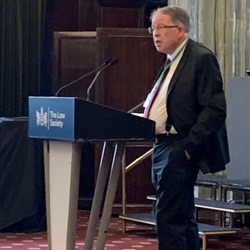
Stephen Larcombe addresses the SGM
The Law Society leadership yesterday fought off a vote of no confidence in how it represents conveyancers but took plenty of criticism along the way – including from one of its own council members.
Although more than 500 solicitors registered to attend the special general meeting (SGM) either in person at the Chancery Lane headquarters or online, only 350 actually voted, with 123 supporting the motion, 207 opposing it and 20 abstaining.
The Law Society has more than 200,000 members.
The motion of no confidence in president Nick Emmerson and chief executive Ian Jeffery was brought by the Property Lawyers Action Group (PLAG).
It was sparked by publication of the fifth edition of the TA6 conveyancing form and its embrace of upfront material information. The Law Society subsequently admitted it should have talked to members about the form, delayed its compulsory introduction by six months and launched a consultation process.
The motion more broadly argued that the society did not have a mandate to engage with the Home Buying and Selling Council (HBSC) and Digital Property Market Steering Group, industry-wide bodies working to reform and digitise conveyancing, without consulting with members.
PLAG chair Stephen Larcombe argued that the HBSC was “dedicated to ‘the dumbing down’ of conveyancing so that [it] can fit the demands of the lawtech sector” and “craves X-Box style conveyancing”.
He described the lawtech sector as “overpowerful, saturated by greed and guilty of considerable hype when marketing its products to solicitors”. However, “the myth of computer infallibility has been shattered” by the Post Office scandal.
“Sadly the Law Society seems all too willing to appease the government and other vested interests by compelling its members to observe policies that are at odds with their historic obligations under the rule of law as guardians of the public’s property interest.”
In response, Mr Jeffery acknowledged that “we don’t always get everything right and when we need to correct things, we will do so”.
He continued: “We launched the fifth edition of TA6 too early. We should have communicated more than we did. The strength of feeling has been heard. That has been a learning experience.”
He assured members that it would be “a genuine consultation” with no predetermined outcome.
To pass the motion, he went on, “may divide our profession and weaken our standing”; refusing to engage with the industry bodies would “marginalise the voice of solicitors and cede our influence in those settings to others”.
Mr Jeffery said it was not the Law Society that was accepting the need for material information – it was laid out in regulations passed in 2008, which National Trading Standards has now issued guidance to help estate agents adopt.
He also rejected PLAG’s argument that the new TA6 would increase the risk of solicitors facing civil or criminal liability – later in the meeting, the Law Society’s head of legal, Shaniah Bart, said leading counsel’s opinion had confirmed that the liability position had not changed. The society would not release it, however, because of privilege.
One speaker from the floor, Andrew England-Kerr, argued that it was “illogical” to say the new form introduced no extra liability when it was much longer than the previous one (32 pages, rather than 18) and asked more questions.
Another leading figure in PLAG, Colin McWilliams, told the meeting: “Conveyancers have simply had enough of this Law Society. We’ve had enough of being told we’re don’t know what’s best for ourselves or our clients. We’ve had enough of not being listened to”.
He suggested that, if the motion were to fail, it would be because of the consultation now underway – a process, he observed, that would not have happened without the motion.
But he expressed no confidence that the consultation would make any difference, even if the majority of members wanted the form ditched.
Some of the speakers who were against the motion were involved in the Law Society – the first two were council members, the third a member of the conveyancing and land law committee – but did not declare their connection.
One of them was Sarah Sargent, a partner and head of residential property at Leeds firm Lupton Fawcett, who represents the society’s leadership and management section on the council.
“Material information is not a new concept, it’s not a new obligation,” she explained. “The Law Society has not been pressured into accepting material information, nor is it something the Law Society has imposed on this profession. It has been a matter of law that consumers should received material information since 2008…
“The proposers appear to be against material information or solicitors having any role in it. You cannot be against something which is a matter of legal fact. And we know that many members are positively engaging with [it]. The majority of the TA6 forms currently being downloaded are the new version, not the old version.”
Many solicitors recognised how important material information was “and it’s not going away”, she insisted – research showed the vast majority of consumers wanted it, while transaction failure after an offer was accepted was a real problem in the market. The new form helped solicitors be “part of the changing process”.
Ms Sargent went on: “So anyone suggesting that material information upfront is not needed is simply incorrect. We should be engaging with estate agents and consumers to educate them on the importance of instructing the solicitor at the earliest possible opportunity.”
Paul Sharma, who represents central London on the governing council, declared his role and focused on the failure to consult.
“What we have is the Law Society at war with its own members. How did we get to this situation? The Law Society operates like the Grand Central Lodge of the Freemasons – everything is secret unless they ordain otherwise.”
It was this “endemic culture of secrecy” that had caused the problem with the TA6. Had the Law Society consulted with local law societies – which he said it treated “like servile fan clubs” – “hundreds of conveyancers would have jumped up and pointed out the dangers of the form. That’s what should have happened”.
Mr Sharma added: “The only reason now it is consulting is because of the danger posed to certain officers – not because they have had a Damascus-style conversion to openness, transparency and democracy.” The SGM, he said, could be “a turning point for democracy”.
Other speakers in favour of the motion were similarly critical of the failure to consult until the Law Society received the requisition for the SGM and questioned how genuine it would be.
Josh Gardner, a director of Busby Solicitors in Cornwall, described it as “too little, too late”, while Andrew Davis, managing partner of East Anglian firm MCP Solicitors, said “we feel betrayed that you are not putting our interests ahead of others. Of course you can be involved and be at the table. The question is, what are you saying at that table?”.
Michael Garson, managing partner of London firm Kagan Moss and a one-time Law Society council member, contended that, “to stay at the table, we need to move with the times”.
“We could not avoid bringing the form up-to-date – the law has changed,” he continued.
Mo Aldridge, a partner at Southampton firm Jasper Vincent, asked who better to have representing the profession “than people who have had their hands slapped?”
In a joint statement after the vote, Amerdeep Somal, chair of the Law Society board, and Mark Evans, deputy vice-president and chair of the SGM, said: “The Law Society council and board fully support the president and CEO and are pleased with the outcome of today’s vote.
“We have listened to the concerns raised by some of our members on this specific issue. It is important to note that we have already taken steps to address these concerns by postponing the compulsory implementation of the updated TA6 form.
“We have also launched a consultation to ensure we understand the full range of member views.”














Leave a Comment